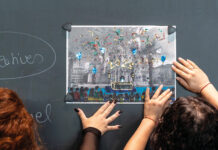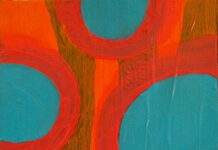
Blitab – A tactile computer tablet for blind people
The Viennese start-up, “Blitab Technology GmbH” founded by Kristina Tsvetanova and Slavi Slavev has developed the first tactile tablet PC. The idea behind the innovation is to enable blind and sight-impaired people to integrate better into digital everyday life.
There are 39.8 million blind people worldwide, and 285.3 million with a severe visual impairment, of whom around 300,000 live in Austria. To date, their only support for participation in our current digital environment is through single-line braille displays, which read off electronic text information, if it is available in a linear format.
With the increase in the use of smartphones, tablet PCs and other applications with touchscreen technology, the way of preparing and presenting digital context has changed dramatically. A large amount of digital content and services are now no longer published on websites for standard PC applications, making them inaccessible for bind people and the visually impaired.
This is where the Blitab created by the Viennese start-up company run by Kristina Tsvetanova and Slavi Slavev comes in. Blitab is a tactile tablet surface which can issue both braille signs and tactile graphic information, and which makes information accessible that cannot be read by standard braille displays for blind people.
Tsvetanova developed the Blitab together with Slavi Slavev and his brother, Stanislav Slavev, both of whom are experts in the field of software and 3D design. The idea for the product came to the young entrepreneur while she was a student. During this time, she met a blind student who needed help registering online for a course.
The Blitab issues not only text, but also graphics and images in braille characters
Together with Slavi Slavev, Kristina Tsvetanova founded the company “Green Vision” in order to develop the first prototype for the Blitab after qualifying as an industrial engineer. Prize money and state funds such as the AWS Impulse XS programme were used as initial funding for the innovative project. An attempt was made to finance the construction of the first prototype through crowdfunding. The combination of technology and added value to society was one of the reasons why the idea won numerous awards, including the Creative Business Cup in 2015 in Copenhagen and the Austrian Social Impact Award in 2014. The product is due for market launch in October 2016.

How the first tactile tablet for blind people works
Among other things, the Blitab is the first product to be able to display an entire page in braille characters – entirely without mechanical elements. In a similar way to an e-book, the Blitab reproduces texts, except it does so in braille. Instead of a screen display, a smooth surface is used which produces bubbles that can be felt. These bubbles take over the function of the mechanical pins in standard braille characters. This makes it possible to transfer text files from USB sticks, memory cards or web browsers in braille. The Blitab is designed as a technical platform for all standard and future software applications. While one half of the braille tablet is used to represent text in braille and graphic elements using physical bubbles, the second half is a touchscreen like the one used in standard tablets and smartphones, which is also fitted with text-to-speech navigation. In this way, the tactile text reproduction is linked to acoustic speech output. Among other things, icons and menus from standard apps are shown on the LCD screen in this section of the Blitab, and the integrated voice output verbalises the meaning of the normally visual icons, or gives information as to which menu the user is currently in. According to Tsvetanova, Blitab differs from other solutions due to the invention of the patented smart liquid technology, which provides new opportunities for representation. In this way, not only text, but also images and graphics can be reproduced. For the first time, images can be converted to a low-pixel resolution and issued on the Blitab. When, for example, an image is shown on a standard touchscreen, it is represented in the top half of the Blitab through conversion into physical bubbles, and in this way, can be “felt” by the blind user.
As a result, the Blitab opens up access for blind people to digital content that they had not been able to use before, during their free time, in many service areas, which are increasingly being made available only online, and not least in schools. When designing the Blitab, particular attention was therefore paid to making it easy and fast to use for all age groups. To ensure optimum implementation of the concept, the Blitab is currently being tested worldwide by 2,500 pupils in 300 schools
Kristina Tsvetanova
CEO & CoFounder
BLITAB Technology
Braille-Tablet
www.blitab.com











